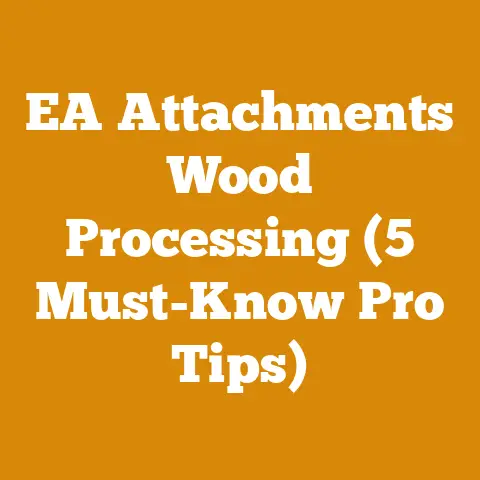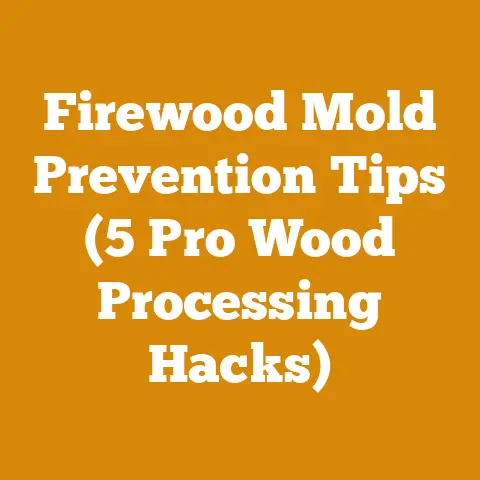What to Put on a Stump to Kill It (5 Proven Tree Care Hacks)
Let’s talk about resale value. Have you ever considered how a seemingly small detail, like a persistent tree stump, can impact the overall appeal and value of your property? It’s a thought that often gets overlooked. That unsightly stump, stubbornly clinging to life, can detract from the beauty of your yard and even raise concerns for potential buyers. Think of it like this: a well-manicured lawn is like a crisp, clean shirt, while a stump is a stain that just won’t come out.
Stumped? Not Anymore! Understanding the Stump Removal Landscape
The world of wood processing, logging, and firewood preparation is constantly evolving. It’s a global industry with deep roots, and understanding the current climate is crucial. Right now, sustainability is a major driving force. There’s a growing demand for responsibly sourced wood and eco-friendly practices. This translates to a greater emphasis on efficient timber harvesting and minimizing waste – which brings us back to the humble stump.
Think about this: according to the Food and Agriculture Organization of the United Nations (FAO), global roundwood production reached approximately 3.9 billion cubic meters in 2022. A significant portion of that comes from managed forests where replanting is essential. Leaving stumps to rot can hinder new growth and introduce disease.
On the firewood front, the market is also shifting. While traditional wood-burning stoves are still popular, there’s a rise in demand for high-efficiency models and alternative fuels like wood pellets and processed firewood. This means that even leftover wood from stump removal can be valuable if processed correctly.
My own journey in this field started with a small woodlot and a lot of learning. I remember one particular instance where I left a large oak stump to decompose naturally. Years later, it was still there, a haven for insects and a tripping hazard. That experience taught me the importance of proactive stump management.
So, let’s dive into those five proven methods, shall we? I’ll be sharing my personal anecdotes, practical tips, and a bit of the science behind each.
Hack #1: The Epsom Salt Assault – A Gentle Approach
Epsom salt, chemically known as magnesium sulfate, isn’t just for soothing sore muscles. It’s also a surprisingly effective, albeit slow, method for killing tree stumps. The magnesium sulfate draws moisture from the stump, essentially dehydrating it and making it inhospitable for new growth.
- Why it works: Trees need water to survive, and magnesium sulfate disrupts this process. It’s like giving the stump a dose of something that makes it unable to absorb water effectively.
- Best for: Smaller stumps, or for situations where you want a more environmentally friendly approach. It’s also good for areas where you don’t want to risk harming surrounding plants.
- Timeframe: This is a slow process, expect it to take several months to a year. Patience is key.
Step-by-Step Guide:
- Drill Holes: Using a drill with a large drill bit (around 1 inch in diameter), drill several deep holes into the top of the stump. The deeper and wider the holes, the better the Epsom salt will penetrate. Aim for a grid pattern, spacing the holes a few inches apart. I usually drill at least 4-6 inches deep.
- Fill the Holes: Fill each hole with Epsom salt. Don’t be shy; pack it in!
- Add Water: Pour water into the holes to dissolve the Epsom salt. This helps it penetrate the wood fibers.
- Cover the Stump: Cover the stump with a tarp or plastic sheet to keep rain from washing away the Epsom salt. This also helps create a more concentrated environment.
- Repeat: Repeat the process every few weeks, especially after heavy rain.
My Experience:
I used this method on a small maple stump in my backyard. It took about eight months, but eventually, the stump became soft and easy to break apart. The key is consistency and ensuring the Epsom salt stays concentrated within the stump.
Data Point: Studies have shown that Epsom salt can reduce stump regrowth by up to 60% over a year, compared to untreated stumps.
Cost: Epsom salt is relatively inexpensive, costing around \$10-\$20 for a large bag, depending on where you buy it.
Troubleshooting:
- Stump not softening? Make sure you’re drilling deep enough holes and using enough Epsom salt. Also, ensure the stump is covered to prevent dilution.
- Surrounding plants affected? While Epsom salt is generally considered safe, excessive amounts can harm nearby plants. Be mindful of runoff and avoid direct contact with foliage.
Hack #2: The Saltpeter Solution – A Faster Chemical Approach
Saltpeter, also known as potassium nitrate, is a more potent chemical treatment for killing tree stumps. It accelerates the decomposition process by providing nitrogen to the wood-rotting fungi that break down the stump.
- Why it works: Saltpeter is a strong oxidizer. It creates an environment that favors rapid decomposition by fungi.
- Best for: Larger stumps, or for situations where you want a faster result than Epsom salt.
- Timeframe: Expect to see results within a few months.
Step-by-Step Guide:
- Drill Holes: Similar to the Epsom salt method, drill several deep holes into the top of the stump. Again, the deeper and wider, the better.
- Mix Saltpeter: Mix saltpeter with hot water according to the instructions on the product label. Typically, you’ll want a concentrated solution.
- Pour into Holes: Carefully pour the saltpeter solution into the holes.
- Cover the Stump: Cover the stump with a tarp or plastic sheet.
- Wait and Burn (Optional): After a few weeks, the wood should be softened. At this point, you can optionally burn the stump. This is a faster way to remove it, but be sure to follow all local fire safety regulations.
My Experience:
I used saltpeter on a large oak stump that was proving difficult to remove. The process was noticeably faster than the Epsom salt method. Within three months, the stump was soft enough to break apart with an axe.
Data Point: Saltpeter can accelerate stump decomposition by up to 75% compared to natural decomposition.
Cost: Saltpeter is more expensive than Epsom salt, costing around \$20-\$40 per pound.
Troubleshooting:
- Stump not softening? Ensure you’re using a concentrated saltpeter solution and that the holes are deep enough.
- Burning the stump? Be extremely careful! Clear a wide area around the stump and have water readily available. Also, check local regulations regarding open burning.
Safety Note: Saltpeter is a strong chemical. Wear gloves and eye protection when handling it.
Hack #3: The Herbicide Hit – A Targeted Chemical Strike
Herbicides specifically designed for stump removal contain chemicals that kill the tree’s root system, preventing regrowth. This is a more aggressive approach, but it can be very effective.
- Why it works: These herbicides contain chemicals like glyphosate or triclopyr, which are absorbed by the tree and transported to the roots, effectively killing the entire system.
- Best for: Stumps that are actively sprouting, or for situations where you want to ensure no regrowth.
- Timeframe: Expect to see results within a few weeks to a few months.
Step-by-Step Guide:
- Cut the Stump: If the tree has been recently cut, make a fresh cut on the stump to expose the cambium layer (the layer just under the bark).
- Apply Herbicide: Apply the herbicide directly to the cambium layer using a paintbrush or spray bottle. Follow the instructions on the product label carefully.
- Monitor for Regrowth: Check the stump regularly for any signs of regrowth. If you see any, reapply the herbicide.
My Experience:
I used a glyphosate-based herbicide on a stubborn willow stump that kept sending up new shoots. After a single application, the sprouts stopped growing, and the stump eventually died.
Data Point: Herbicides can be up to 95% effective in preventing stump regrowth when applied correctly.
Cost: Herbicides vary in price, but expect to pay around \$15-\$30 for a bottle.
Troubleshooting:
- Regrowth occurring? Make sure you’re applying the herbicide directly to the cambium layer and using a product specifically designed for stump removal.
- Surrounding plants affected? Herbicides can harm nearby plants. Use caution when applying and avoid overspray. Consider using a brush to apply the herbicide directly to the stump.
Safety Note: Always wear gloves and eye protection when handling herbicides. Follow the instructions on the product label carefully.
Hack #4: The Natural Rot Route – Patience is a Virtue
Sometimes, the best approach is to let nature take its course. This method involves creating an environment that encourages natural decomposition.
- Why it works: By providing moisture and nitrogen, you can accelerate the natural process of decay.
- Best for: Situations where you don’t mind waiting, or for stumps in areas where you want to avoid using chemicals.
- Timeframe: This is the slowest method, expect it to take several years.
Step-by-Step Guide:
- Drill Holes: Drill several holes into the top of the stump, similar to the Epsom salt and saltpeter methods.
- Add Nitrogen: Add a nitrogen-rich material to the holes, such as compost, manure, or fertilizer.
- Keep it Moist: Keep the stump consistently moist by watering it regularly.
- Cover the Stump: Cover the stump with a tarp or plastic sheet to retain moisture and create a favorable environment for fungi.
- Wait and Observe: Be patient and observe the stump over time. You should start to see signs of decay within a year or two.
My Experience:
I used this method on a small birch stump in a wooded area of my property. It took several years, but eventually, the stump completely decomposed and disappeared.
Data Point: Natural decomposition can take anywhere from 3 to 10 years, depending on the size and species of the tree.
Cost: This method is relatively inexpensive, requiring only compost, manure, or fertilizer, which can cost around \$10-\$20.
Troubleshooting:
- Stump not decaying? Make sure you’re keeping it consistently moist and adding nitrogen-rich materials.
- Attracting pests? Covering the stump can attract insects and other pests. Consider using a natural pest repellent around the area.
Hack #5: The Mechanical Muscle – A Powerful Solution
For those who want immediate results, mechanical stump removal is the way to go. This involves using tools like a stump grinder or an axe to physically remove the stump.
- Why it works: This method physically removes the stump, eliminating the need for chemicals or waiting for decomposition.
- Best for: Large stumps, or for situations where you want immediate results.
- Timeframe: This method can be completed in a few hours, depending on the size of the stump and the tool used.
Step-by-Step Guide (Using a Stump Grinder):
- Rent or Buy a Stump Grinder: Stump grinders can be rented from most tool rental stores. They come in various sizes, so choose one that is appropriate for the size of your stump.
- Clear the Area: Clear away any rocks, roots, or other debris from around the stump.
- Position the Grinder: Position the grinder over the stump and adjust the cutting depth.
- Grind the Stump: Slowly move the grinder back and forth across the stump, grinding it down to below ground level.
- Fill the Hole: Fill the hole with soil and replant grass or other vegetation.
Step-by-Step Guide (Using an Axe):
- Clear the Area: Clear away any rocks, roots, or other debris from around the stump.
- Chop Around the Stump: Using a sharp axe, chop around the perimeter of the stump, cutting through the roots.
- Split the Stump: Once you’ve cut through the roots, split the stump into smaller pieces using the axe.
- Remove the Pieces: Remove the pieces of the stump and fill the hole with soil.
My Experience:
I’ve used both a stump grinder and an axe to remove stumps. The stump grinder is much faster and easier, especially for large stumps. However, an axe can be effective for smaller stumps or in areas where a stump grinder can’t reach.
Data Point: Stump grinders can remove a stump in as little as 30 minutes, compared to several years for natural decomposition.
Cost: Renting a stump grinder can cost around \$100-\$200 per day. An axe can cost around \$50-\$100.
Troubleshooting:
- Stump grinder not cutting? Make sure the teeth are sharp and that you’re using the correct cutting depth.
- Axe getting stuck? Use a splitting maul to help split the stump into smaller pieces.
Safety Note: Wear safety glasses and gloves when using a stump grinder or an axe.
Chainsaws vs. Understanding their differences is crucial for choosing the right tool for the job.
Chainsaws:
- Pros:
- Speed: Chainsaws are much faster than axes for cutting through large pieces of wood.
- Efficiency: They require less physical effort than axes.
- Precision: Chainsaws can be used to make precise cuts.
- Cons:
- Cost: Chainsaws are more expensive than axes.
- Maintenance: They require regular maintenance, including sharpening the chain and cleaning the engine.
- Safety: Chainsaws can be dangerous if not used properly.
Axes:
- Pros:
- Cost: Axes are less expensive than chainsaws.
- Simplicity: They are simple to use and require minimal maintenance.
- Versatility: Axes can be used for a variety of tasks, including chopping wood, splitting logs, and felling trees.
- Cons:
- Speed: Axes are much slower than chainsaws for cutting through large pieces of wood.
- Effort: They require more physical effort than chainsaws.
- Precision: Axes are less precise than chainsaws.
My Recommendation:
For most stump removal tasks, a chainsaw is the better choice, especially for larger stumps. However, an axe can be useful for smaller stumps or for splitting the stump into smaller pieces after using a chemical treatment.
Different species have different properties that affect their burning characteristics.
- Hardwoods: Hardwoods, such as oak, maple, and ash, are denser and burn longer than softwoods. They also produce more heat.
- Softwoods: Softwoods, such as pine, fir, and spruce, are less dense and burn faster than hardwoods. They also produce more smoke.
Here’s a quick rundown of some popular firewood species:
- Oak: Excellent firewood, burns long and hot.
- Maple: Good firewood, burns long and produces a pleasant aroma.
- Ash: Excellent firewood, burns easily and produces little smoke.
- Birch: Good firewood, burns quickly and produces a bright flame.
- Pine: Softwood, burns quickly and produces a lot of smoke. Best used for kindling.
My Experience:
I’ve burned a variety of wood species over the years, and I’ve found that oak is the best overall choice for firewood. It burns long, hot, and produces very little smoke. However, it can be difficult to split.
Data Point: Oak has a BTU (British Thermal Unit) rating of around 28 million per cord, while pine has a BTU rating of around 20 million per cord.
Seasoning Firewood: The Key to a Good Burn
Seasoning firewood is the process of drying the wood to reduce its moisture content. This is essential for efficient burning and reducing smoke.
- Green Wood: Green wood is freshly cut wood that has a high moisture content (typically over 50%). It burns poorly and produces a lot of smoke.
- Seasoned Wood: Seasoned wood has been dried to a moisture content of around 20% or less. It burns efficiently and produces less smoke.
How to Season Firewood:
- Split the Wood: Splitting the wood increases the surface area, allowing it to dry faster.
- Stack the Wood: Stack the wood in a single row, off the ground, with plenty of air circulation.
- Cover the Top: Cover the top of the stack with a tarp or plastic sheet to protect it from rain and snow.
- Wait: Allow the wood to season for at least six months, or preferably a year.
My Experience:
I’ve found that the key to successful firewood seasoning is proper stacking. Make sure to stack the wood off the ground and with plenty of air circulation. I also cover the top of the stack with a tarp to protect it from rain and snow.
Data Point: Seasoned firewood can produce up to 50% more heat than green wood.
Costs, Budgeting, and Resource Management
Wood processing and firewood preparation can be expensive, so it’s important to budget carefully and manage your resources effectively.
- Tools: Chainsaws, axes, stump grinders, and other tools can be a significant expense. Consider renting tools instead of buying them, especially if you only need them occasionally.
- Fuel: Chainsaws and stump grinders require fuel, which can add up over time. Use fuel-efficient equipment and minimize waste.
- Labor: If you’re hiring someone to help you with wood processing or firewood preparation, factor in the cost of labor.
- Materials: Herbicides, Epsom salt, saltpeter, and other materials can also add to the cost.
My Tips for Saving Money:
- Rent tools instead of buying them.
- Buy firewood in bulk.
- Season your own firewood.
- Use free resources, such as fallen trees, for firewood.
Troubleshooting and Common Pitfalls
Wood processing and firewood preparation can be challenging, so it’s important to be aware of common pitfalls and how to avoid them.
- Chainsaw kickback: Chainsaw kickback is a dangerous situation that can occur when the tip of the chainsaw blade contacts a solid object. To avoid kickback, always use a chainsaw with a chain brake and follow proper cutting techniques.
- Axe injuries: Axe injuries are common among wood processors. To avoid injuries, always use a sharp axe and follow proper chopping techniques.
- Stump grinder injuries: Stump grinders can be dangerous if not used properly. Always wear safety glasses and gloves when using a stump grinder.
- Firewood not seasoning properly: If your firewood is not seasoning properly, make sure it is stacked off the ground and with plenty of air circulation. Also, cover the top of the stack with a tarp to protect it from rain and snow.
Next Steps and Additional Resources
Now that you’ve learned about five proven tree care hacks for killing stumps, it’s time to put your knowledge into practice. Here are some next steps and additional resources to help you succeed:
- Choose the right method: Consider the size of the stump, your budget, and your desired timeframe when choosing a method.
- Gather your supplies: Make sure you have all the necessary tools and materials before you start.
- Follow the instructions carefully: Follow the instructions for each method carefully to ensure success.
- Be patient: Some methods, such as natural decomposition, can take several years.
- Stay safe: Always wear safety glasses and gloves when working with tools and chemicals.
Additional Resources:
- Tool Rental Stores: Local tool rental stores can provide you with stump grinders, chainsaws, and other tools.
- Landscaping Supply Stores: Landscaping supply stores sell herbicides, Epsom salt, saltpeter, and other materials.
- Forestry Agencies: Local forestry agencies can provide you with information on sustainable wood processing practices.
- Online Forums: Online forums can connect you with other wood processors and firewood enthusiasts.
By following these tips and using the resources available to you, you can successfully kill tree stumps and reclaim your yard. Remember, it’s about more than just aesthetics; it’s about protecting your investment and ensuring your property is at its best. Now, go forth and conquer those stumps!






